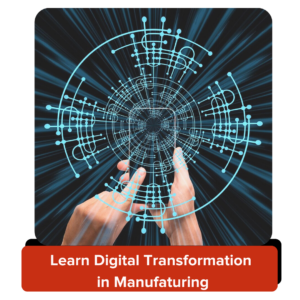Since the early days of the First Industrial Revolution, manufacturers have moved quickly to embrace manufacturing innovation, continually progressing from traditional manufacturing. From water-powered looms to electric factories, mechanized assembly lines to industrial robots, anything that can help then be more competitive, they’ll put it to work. Greater efficiency? Streamlined operations? Increased productivity? Better quality? Less downtime? It all matters when it comes to advanced manufacturing.
Today, as we enter the fourth Industrial Revolution, the pace of innovation is only accelerating. And manufacturers continue to adapt the manufacturing process, looking for new ways to work smarter and make better products in less time at a lower cost. After all, they know their competitors have the same goals, and they can’t risk being left behind.
So, What is Advanced Manufacturing?
What we mean by “advanced manufacturing” is always changing—and the changes are far from over. But the tools and technologies of Industry 4.0 offer new possibilities. From new materials and innovative approaches to fabrication to technological advancements, artificial intelligence, and automation, let’s take a look at what innovative manufacturers are doing to move ahead.
Additive Manufacturing
Casting and subtractive processes like milling were the backbones of mass production in the 20th century. In the 1990s, advances in digital technologies and materials science came together to enable a new approach: additive manufacturing, commonly known as 3D printing. Instead of pouring materials into molds or removing materials from a block, small layers of material are laid down sequentially, adding up to a finished form based on digital instructions.
The first applications used plastic polymers and were relatively small in scale, providing limited use for prototyping and scale models. Hobbyists loved it. Today, additive processes like powder bed fusion, fused deposition modeling (FDM), and selective laser sintering (SLS) are enabling teams to produce durable metal forms that can be used in everything from mining and heavy industry to aerospace.
What makes additive so appealing? Simply put: there’s no form it can’t make. Casting and subtractive present limitations on the shapes that can be mass-produced—and that will never change. With 3D printing, there are basically no limits in the advanced manufacturing industry.
In its early years, the formal freedom of additive was countered by relatively slow production speeds and high costs. But with every passing year, advanced manufacturing technology is getting faster and cheaper. In many ways, the era of additive is just beginning.

Advanced Manufacturing Materials
Ceramics, glass, steel, plastics—each of these was an advanced material in its time. But each had flaws. And the journey isn’t over. From new metal alloys that are stronger and more versatile than ever before to high-performance ceramics that never corrode, researchers continue to innovate, reformulate, and combine, creating new materials engineered for specific qualities and purposes that can help the industry move forward.
You don’t have to stick to a single material, either. Composites—combinations of two or more materials into a single product—are creating new possibilities. Carbon fiber is the one most of us know—it weaves strands of carbon into high-performance plastics, increasing strength while reducing weight. You’ll find it in everything from high-performance bicycles to the latest spacecraft. But the world of composites is nearly infinite, with new combinations of metal, advanced ceramics, plastic, and glass opening new possibilities every day, expanding advanced manufacturing techniques along the way.
New Subtractive Techniques
We’ve been doing subtractive manufacturing since the first person chiseled a stone, knapped flint, whittled a stick, or milled a plank. Start with a block of material and remove what you don’t want—that’s the essence of subtractive. And it will always be relevant for the industry.
When it comes to precision, efficiency, and volume, CNC machines have replaced hand routing in most contexts, and 5-axis machines are doing things that 3-axis machines simply can’t in a manufacturing system. Ultimately, it’s all about freedom and efficiency—freedom in design, and efficiency in production.
Robotics and Automation
We’ve had robots on assembly lines since the 1960s, but those units were big, expensive, and took months to program. Only highly trained specialists could do the job, and if things changed around them by even an inch, those early robots were not only useless but often dangerous.
Today’s robots come in all sizes, and advances in both hardware and software enable them to be trained in hours or days instead of weeks or months, even by workers with no background in robotics. What’s more, breakthroughs in machine vision and other sensors enable these devices to be aware of and respond to dynamic conditions in their surroundings so that they can function safely around humans while increasing product quality. Some can even monitor their own work and adapt to achieve stated goals on the fly. And while the first industrial robots cost millions, price tags start around $35,000 for popular models today, putting them within reach for many manufacturers.
Cloud Computing, Mobile Tech, and Remote Collaboration
Project data used to be difficult to manage. Who had which version? Who owns the truth? Plans were delivered first on paper, then on disk, then by email. Which was worse?
Using the cloud, teams can share a single source of truth that’s constantly updated, with access and permissions based on role. Multiple designers can work together on the same project with engineers and other stakeholders from anywhere, collaborating in real-time, without work being lost, which helps to increase the efficiency in the advanced manufacturing sector. And workers on the line can access that file on a tablet or other mobile device, adding production data in real-time. Efficiency goes up, while waste—and wasted time—goes down.
Don’t Just Keep Up with Advanced Manufacturing, Get Ahead
“Advanced” is one of those words that doesn’t mean much until you answer the question, “Compared to what?” It’s a word that we’ll continue to use as the technologies described here become commonplace. By then, we’ll be using it to talk about tech that’s still in the R&D phase and being pioneered in university labs.
Each new advanced manufacturing technology brings new possibilities. To stay competitive, you have to keep learning, investing, and adapting with cutting-edge technology. The right partner makes a difference. KETIV experts can help you evaluate the options, figure out which ones can make the biggest difference for your processes and products, then help you implement the solutions and tools and train your team in the manufacturing sector. When you’re ready to take the next step in the advanced manufacturing industry, the KETIV team is here to help. Discover more Advanced Manufacturing solutions on our YouTube channel Advanced Manufacturing playlist.
